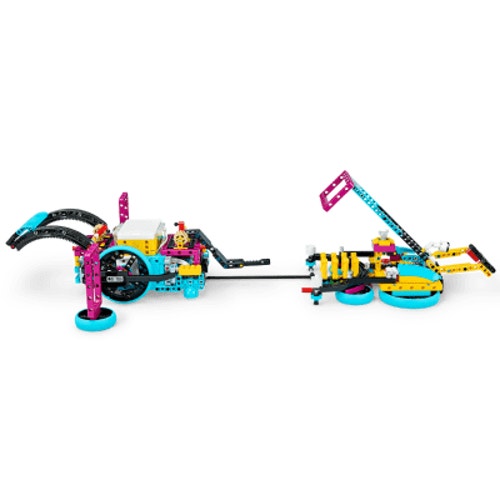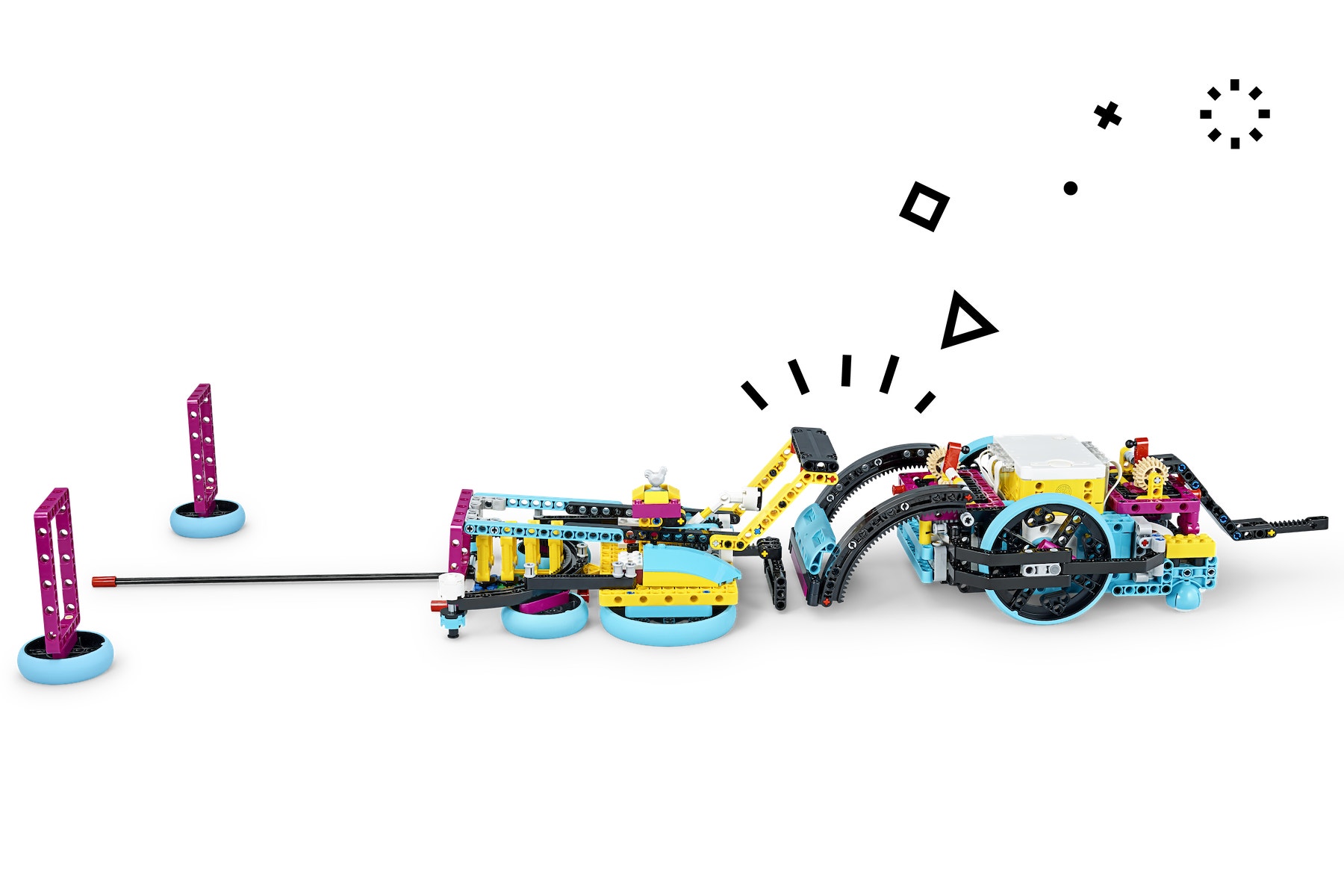Mission Ready
Use controlled motor movements, sensors, and organized programs to solve a practice competition challenge in the shortest amount of time.

Lesson plan
1. Prepare
- Read through the student material in the LEGO® Education SPIKE™ App.
- Plan accordingly, this project is designed to be run over multiple sessions.
- To complete this lesson, your students will have to have built the Advanced Driving Base model and the Dozer Blade and Lift Arm tools.
2. Engage (10 Min.)
- Use the ideas in the Ignite a Discussion section below to engage your students in a discussion related to this lesson.
- Use the video to explain the lesson.
3. Explore (30 Min.)
- Have your students work in pairs to build the Game Module, Path, and Field Marker models.
- Ask them to work together to write a program for their Advanced Driving Base that solves the competition challenge. Remind them to use everything they've learned up until now.
4. Explain (10 Min.)
- Facilitate a discussion about the importance of planning each step of a program. Discuss the use of pseudocode and My Blocks to help with the planning.
5. Elaborate (40 Min.)
- Let your students continue to work on their solutions until they're ready for a timed trial.
- Remind them to start by writing pseudocode.
- Don't forget to leave some time for cleanup.
6. Evaluate
- Give feedback on each student's performance.
- You can use the assessment rubrics provided to simplify the process.
Ignite a Discussion
Use these questions to engage your students in a discussion about how they can use what they've learned so far to successfully solve this challenge:
- What is decomposition of a problem?
- How will you use this skill to help complete this challenge?
- What skills have you learned over the previous lessons that'll help you to successfully complete this mission?
Have your students watch this video to see what they're about to do.

Building Tips
Example Game Context
Use this theme, or create your own:
- The farmer has gone on vacation, so he needs help programming his robotic farmhand to collect the eggs without breaking them.
Game Elements
You'll need:
- Advanced Driving Base with tools
- Game Module combined with the Path model
- 2 x Markers
- 4 x Crates
- 6 x Penalty Bricks

Mission 1: Unlock the gate
Program the Advanced Driving Base to push in the actuator to unlock the Game Module gate.

Mission 2: Open the gate
Program the Advanced Driving Base to push down on the latch to open the Game Module gate.

Mission 3: Pass the marker
Navigate the field and pass at least one Marker without touching it.
Mission 4: Follow the path and collect the Crates
Guide the Advanced Driving Base toward the Game Module and collect the Crates.

Mission 5: Safely deliver the Crates
Deliver the Crates to the outside of the two markers.
Brick Penalties (Optional)
- Collisions with Markers when carrying Crates
- Any instance of picking up, removing, or re-placing the robot
A maximum of six penalty bricks can be given.
Each penalty brick will result in 5 points being deducted from the final score.
Scoring
- Unlocking the gate (10 pts)
- Opening the gate (10 pts)
- Passing the Marker (10 pts)
- Following the Path and collecting the Crates - collect at least 2 Crates (10 pts per crate); 10 bonus pts if all four crates are collected
- Safe delivery of one or more Crates 50 cm away from the hen to finish (20 pts)
Coding Tips
Main Program

Differentiation
Simplify this lesson by:
- Solving one part of the mission with your students as a group
Take this lesson to the next level by:
- Using the optional brick penalties as part of the game
- Challenging your students to complete all of the missions as quickly as possible and with no penalties
- Changing the field setup and inventing new rules
- Adding lines to the table to add complexity to the challenge
Assessment Opportunities
Teacher Observation Checklist
Create a scale that matches your needs, for example:
- Partially accomplished
- Fully accomplished
- Overachieved
Use the following success criteria to evaluate your students' progress:
- Students worked well as a team to complete one mission.
- Students worked together as a team to complete all of the missions.
- Students can present their robot, program, and mission strategy, explaining how they've successfully completed each mission.
Self-Assessment
Have each student choose the brick that they feel best represents their performance.
- Blue: I've successfully completed one mission.
- Yellow: I've successfully completed all of the missions.
- Violet: Along with my team, I've presented our robot, program, and mission strategy to our coach with each team member participating.
Peer-Assessment
Encourage your students to provide feedback to others by:
- Having one student score the performance of another using the colored brick scale above.
- Asking them to present constructive feedback to each other so that they can improve their group's performance during the next lesson.

Language Arts Extension
To incorporate language arts skills development:
- Have your students prepare and deliver a presentation about how they developed an effective strategy for completing the challenge in the shortest amount of time.
Note: This will make for a longer lesson.
Career Links
Students who enjoyed this lesson might be interested in exploring these careers pathways:
- Business and Finance (Entrepreneurship)
- Manufacturing and Engineering (Pre-Engineering)
Teacher Support
Students will:
- Demonstrate their skills by solving a timed competition challenge
LEGO® Education SPIKE™ Prime Set
LEGO® Education SPIKE Prime Expansion Set
NGSS
MS-ETS1-4
Develop a model to generate data for iterative testing and modification of a proposed object, tool, or process such that an optimal design can be achieved.
CSTA
2-AP-11 6-8
Create clearly named variables that represent different data types and perform operations on their values.
2-AP-14 6-8
Create procedures with parameters to organize code and make it easier to reuse.
2-AP-19 6-8
Document programs in order to make them easier to follow, test, and debug.
Common Core
CCSS.MATH.CONTENT.7.G.B.4
Know the formulas for the area and circumference of a circle and use them to solve problems; give an informal derivation of the relationship between the circumference and area of a circle.
CCSS.ELA-LITERACY.W.6.1
Write arguments to support claims with clear reasons and relevant evidence.
Analyze proportional relationships and use them to solve real-world and mathematical problems.




